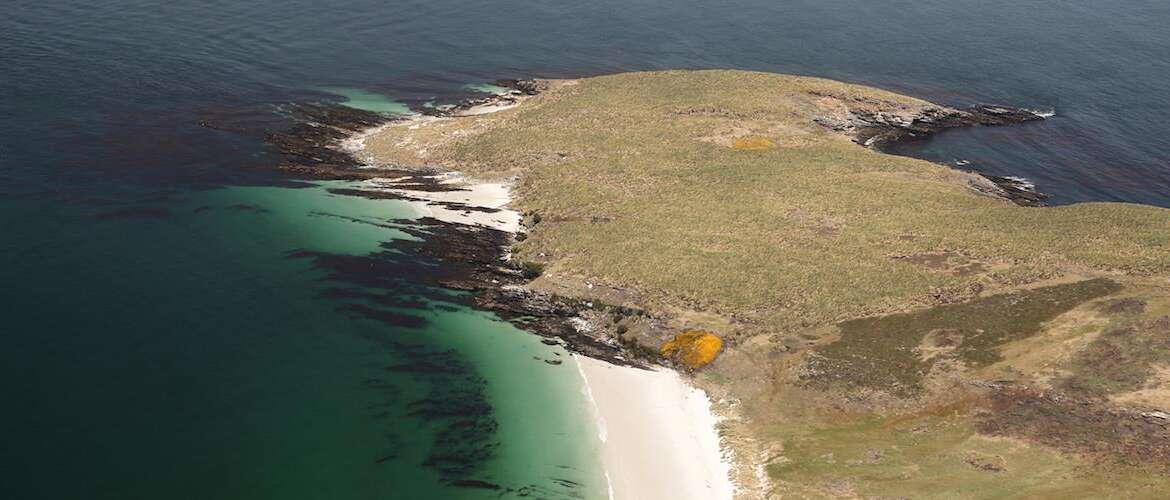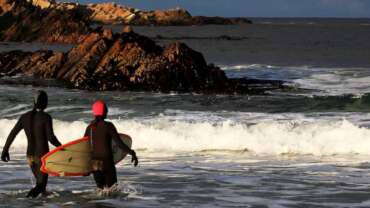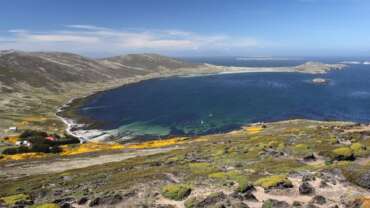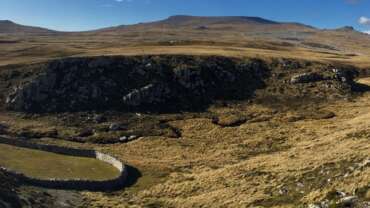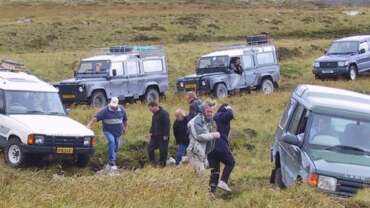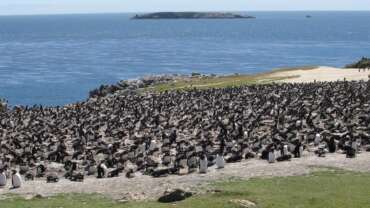West Falkland
West Falkland has a scattered population across a number of settlements and farms. Characterised by rugged hills and spectacular coastline, the West is home to a variety of wildlife, great hill-walking opportunities and a chance to really get away from it all.
There are many places to stay on West Falkland including the comfortable Port Howard Lodge, farm-stays and homely cottages. Itineraries can easily be organised to include a range of destinations or a short stop-over to get a feel for the way of life on this island.
The Concordia Bay ferry runs from New Haven on East Falkland to Port Howard on the West. Dolphins frequently swim alongside as the boat nears a landing and there is a sense of being able to reach out and almost touch the land either side as the vessel makes its way through the narrows to Port Howard. The voyage is around two hours and can be undertaken as a foot passenger or with a vehicle.
Most international visitors are more likely to travel to West Falkland with the Government Air Service (FIGAS), landing on one of the many airstrips serving the small communities of the West. Accommodation providers will arrange a transfer service and further transportation to the various points of interest. Roads link the main settlements and farms, with off-road experiences available to more remote locations. Vehicle tours are on offer.
There is much to see. The largest settlements of Fox Bay and Port Howard are excellent jump-off points whilst smaller settlements provide an enjoyable feeling of isolation and a break from the rigours of everyday life. Take time to explore the coastline on foot, watch the wildlife, do some fishing, climb one of the West’s many hills or simply relax and admire the dramatic views.
West Falkland beckons to be part of any island-hopping itinerary.
Northern Section
The northern part of West Falkland has lovely coastline with idyllic inlets and bays offering great areas for exploration and superb views. Mount Adam, the highest point on the West at 700 metres (2297 feet) is located towards the north-west; an exhilarating hike to the top affords fantastic views. The Warrah is a short but wide river, excellent for fishing with a good reputation for the size and quality of fish. The Falklands’ largest “forest” is also situated in the north of West Falkland at Hill Cove.
Some settlements have visitor accommodation with various attractions and activities. All can be reached with the Falkland Islands Government Air Service (FIGAS) and are linked by a road network.
Port Howard is an attractive sheep farming settlement on the east coast, nestled under Mount Maria 658 metres (2158 feet). It is easy to explore on foot; a gentle stroll will take in the harbour area, pretty settlement buildings, a small museum with memorabilia from the 1982 war and a little further afield the local cemetery, which includes the grave of Captain Hamilton who lost his life in 1982. Mount Maria is an excellent walk providing stunning views across Falkland Sound. Guided tours and fishing expeditions can also be organised.
Shallow Bay and Hill Cove are located on the northern coast with amazing vistas of the north-west islands. Crooked Inlet Farm at Roy Cove is situated on the western shore, tucked into a picturesque bay with lovely views across to outlying islands.
These places are all perfect jump-off points for that strenuous trek up Mount Adam, exploration of Hill Cove forest, fishing expeditions and the leisurely soaking up of farm-life. Enjoy beach-combing, birding or relaxed rambles around the settlements and shores.
Tours can be organised to include Grave Cove at Dunbar to see spectacular scenery and the only black-browed albatross colony on West Falkland.
There are several accommodation options in the Northern Section of West Falkland. Port Howard Lodge in the east offers catered accommodation while in the west, Crooked Inlet at Roy Cove and Shallow Bay Cottage both offer self-catering.
Southern Section
Travel south by road on West Falkland and you will encounter changing landscapes as the route twists and turns through valleys, alongside hills and through the lakelands. Much of the landscape is hilly with lovely cliffs sweeping down to the turquoise-blue seas.
Excellent fishing opportunities are available on the Chartres and Malo Rivers and around smaller creeks and the shores. There are many wildlife watching locations and great hikes.
Settlements in the south with visitor accommodation are Fox Bay West, Port Edgar and Port Stephens. These can be accessed via the road network or a flight with the Falkland Islands Government Air Service.
Intrepid visitors can camp at the Patricia Luxton National Nature Reserve which must be reached by road. This is the perfect spot if you want to truly escape civilisation! Nearby are Hawk’s Nest Ponds, a peaceful area of flat land, ideal for easy walking and birding.
On the east coast, Fox Bay West offers access to fishing on the River Malo, and the beautiful beach and penguin rookery at Fox Bay Mountain. Across the harbour at Fox Bay East is a memorial to the events of the 1982 occupation. Black Shanty House provides visitors with self-catering accommodation.
Port Edgar is also located on the east coast in a large, sheltered natural harbour. There are fantastic walking opportunities from short strolls around the settlement to longer hikes for great views, lovely white sand beaches and wildlife.Try your hand at fishing or observe life around the farm, including sheep shearing, if happening. Self-catering accommodation is provided at Moelwyn Cottage.
Port Stephens is situated in the south-west of West Falkland, at the end of the road. The amazing coastline gives stunning views across the ocean; gentoo, Magellanic and rockhopper penguins can all be found here. Discover too, the unusual rock formations known locally as Indian Village. Visitors can stay at Port Stephens Cottage on a self-catering basis.



